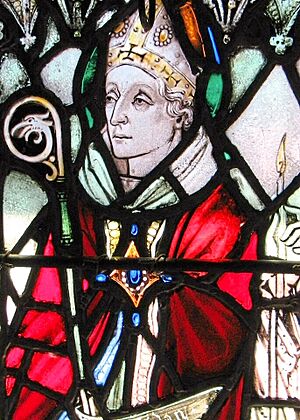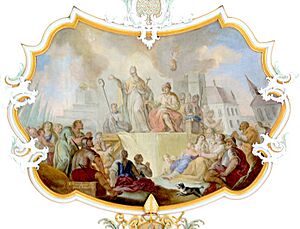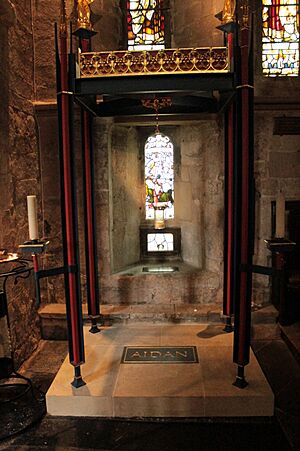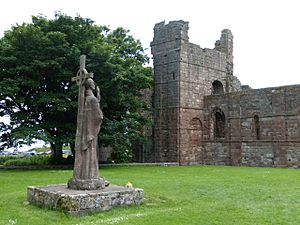Aidan of Lindisfarne facts for kids
Quick facts for kids SaintAidan of Lindisfarne |
|
|---|---|

Stained glass at Holy Cross Monastery
|
|
| Bishop | |
| Born | c. 590 Ireland |
| Died | 31 August 651 Parish Churchyard, Bamburgh, Northumberland |
| Venerated in | |
| Major shrine | Originally Lindisfarne Abbey, Northumberland; later disputed between Iona Abbey and Glastonbury Abbey (all destroyed) |
| Feast |
|
| Attributes |
|
| Patronage | |
Aidan of Lindisfarne (died August 31, 651) was an Irish monk and missionary. He is famous for bringing Christianity to the Anglo-Saxons in a part of England called Northumbria. Aidan started a special church and monastery on the island of Lindisfarne. This place became known as Lindisfarne Priory. He was also its first bishop. Aidan traveled all over the countryside, sharing the Christian message with everyone. He spoke to both important leaders and ordinary people, including children and those who were enslaved.
He is often called the Apostle of Northumbria. An "apostle" is someone who spreads an important new teaching. Aidan is recognized as a saint by the Catholic Church, the Eastern Orthodox Church, the Anglican Communion, and other Christian groups.
Aidan's Life Story
Most of what we know about Aidan comes from the writings of a monk named Bede. Bede wrote a detailed history of the English Church. He tells us that Aidan was an Irish monk from a young age. He lived at a very old monastery on the island of Iona. This island is located off the coast of Scotland.
Early Life and Mission
Aidan was born around the year 590, possibly in Connacht, Ireland. His name, Aidan, means 'little fiery one' in Old Irish. Before Aidan's mission, Christianity in Britain was fading away. Many people were following Anglo-Saxon paganism, which was a different religion.
A young prince named Oswald of Northumbria grew up at the Iona monastery. He had been sent there when he was exiled from his home. Oswald became a Christian while at Iona. When he became King of Northumbria in 634, he wanted to bring Christianity back to his people.
King Oswald asked the monks at Iona to send missionaries. At first, they sent a bishop named Cormán. But Cormán was too strict and didn't succeed. He went back to Iona and said the Northumbrians were too difficult to convert. Aidan disagreed with Cormán's approach. Soon after, Aidan was chosen to go instead. He became a bishop in 635.
Spreading Christianity
Aidan worked closely with King Oswald, who was a very religious king. Aidan chose the island of Lindisfarne for his main church. Lindisfarne was a good choice because it was close to the king's castle at Bamburgh. Aidan was a very inspiring missionary. He would walk from village to village, talking kindly to people. He slowly got them interested in Christianity.
He believed in teaching people gently, step by step. He would first share simple ideas, then help them understand deeper truths. Aidan and his monks patiently talked to people. They showed interest in their lives and communities. This way, they slowly brought Christianity back to Northumbria. King Oswald had lived in exile and spoke Irish perfectly. He often helped translate for Aidan and his monks, who didn't speak English at first.
During his time as a missionary, Aidan built many churches, monasteries, and schools. He was also known for his great kindness and care for those in need. For example, he often gave orphans a place to live, food, and an education. He also used money he received to buy the freedom of people who had been unfairly enslaved.
Bede wrote that Aidan always traveled on foot, unless it was absolutely necessary to ride a horse. He would talk to everyone he met, rich or poor. He encouraged them to become Christians or to grow stronger in their faith. Aidan and his companions spent their days reading scriptures, praying, and thinking about holy truths. If he was invited to eat with the king, he would quickly finish his meal and leave to continue his studies. Many people followed his example, fasting on Wednesdays and Fridays. Aidan never kept money given to him by rich people. He always gave it to the poor or used it to free enslaved people. He even taught many of the freed people and helped them become priests.
The monastery Aidan founded on Lindisfarne grew very important. It helped start other churches and religious places. It also became a center for learning and knowledge. Many young people were trained there to become priests. Even though Aidan followed the Irish way of Christianity, his strong character and missionary work earned him respect from important leaders like Pope Honorius I.
When King Oswald died in 642, Aidan continued to receive support from the new king, Oswine of Deira. Aidan and Oswine became close friends. Aidan's work continued peacefully until 651, when there was a rise in pagan attacks.
One story tells of a time when an enemy army, led by Penda, attacked Northumbria. They tried to burn down the royal city of Bamburgh. Aidan was on a nearby island, praying alone. When he saw the city on fire, he cried out to God. Right after he prayed, the wind changed direction. It blew the flames back onto the attackers, scaring them away. They realized the city was protected by God.
Aidan's Legacy
After Aidan died, he was buried at Lindisfarne, under the monastery he helped build. Even though his fame changed over the years, his memory was kept alive. In the 11th century, monks from Glastonbury Abbey obtained some of his supposed relics. This helped keep his story and importance known.
Aidan's feast day (a special day to remember a saint) is celebrated on August 31, the day he died. Because he was Irish, worked in Scotland, and helped the English, some people have suggested Aidan could be a patron saint for the whole of the United Kingdom.
Aidan is honored in the Church of England and the Episcopal Church on August 31. St Aidan's College at the University of Durham is named after him.
See Also
- List of Christian saints




